Sociology > QUESTIONS & ANSWERS > CHCECE002 Ensure the health and safety of children Theory Assessment Task (All)
CHCECE002 Ensure the health and safety of children Theory Assessment Task
Document Content and Description Below
CHCECE002 Ensure the health and safety of children Theory Assessment Task Unit Purpose The assessment tasks within this unit provide you with the opportunity to demonstrate evidence of the r... equired knowledge and skills to ensure the health and safety of children. Elements The following elements define the essential outcomes of this unit: Element 1 Support each child’s health needs Element 2 Provide opportunities to meet each child’s need for sleep, rest and relaxation Element 3 Implement effective hygiene and health practices Element 4 Supervise children to ensure safety Element 5 Minimise risks Element 6 Contribute to the ongoing management of allergies Element 7 Contribute to the ongoing management of asthma Assessment Requirements • 001: Children’s Health and Safety and Legislation • 002: Infection Control • 003: Provide a Safe Environment • 004: Accident Prevention • 005: Supervision • 006: Administration of Medications • 007: Promoting Children’s Health and Hygiene • 008: Asthma and Allergies Required Readings In order to complete this unit of competency you are required to access the following key resources. Textbook • Kearns, K. (2017). The Big Picture: Working in Early Childhood Education and Care Series (4th ed.). Victoria: Cengage Learning Australia. Core Documents • Education and Care Services National Regulations. (2011). Ministerial Council for Education, Early Childhood Development and Youth Affairs. Retrieved from: http://www.legislation.nsw.gov.au/sessionalview/sessional/subordleg/2011-653.pdf • Guide to the National Quality Standard. (2013). Australian Children’s Education and Care Quality Authority. ACT: Commonwealth of Australia. Retrieved from: http://files.acecqa.gov.au/files/National-Quality-Framework-Resources-Kit/NQF03-Guide-to-NQS-130902.pdf Additional Readings for this Unit • Asthma Foundations of Australia. (2009). Asthma in the under 5s. Retrieved from: http://www.asthmawa.org.au/Documents/brochures/Asthma_in_the_Under_5s.pdf (Accessed April, 2015). • Australasian Society of Clinical Immunology and Allergy Inc. (2013). Action Plan for Anaphylaxis – For use with EpiPen® adrenaline auto injectors. NSW: NSW Government Ministry of Health. • Kidsafe. (2008). Moveable Equipment Safety Checklist. Retrieved from: http://www.kidsafensw.org/imagesDB/wysiwyg/MoveableEquipmentSafetyChecklist2014.pdf (Accessed April, 2015). • National Health and Medical Research Council. (2012). Staying Healthy: Preventing infectious diseases in early childhood education and care services (5th ed.). ACT: Commonwealth of Australia. Retrieved from: http://www.nhmrc.gov.au/_files_nhmrc/publications/attachments/ch55_staying_healthy_childcare_5th_edition_0.pdf (Accessed April, 2015). • NSW Little Smiles. (2010). Dental Health Resource Package for Childcare Professionals. NSW: Department of Health. Retrieved from: http://www.health.nsw.gov.au/pubs/2009/pdf/nsw_little_smiles.pdf (Accessed April, 2015). • The Royal Children’s Hospital. (2008). Safety Centre: Toy safety for pre-school. Retrieved from: http://www.rch.org.au/uploadedFiles/Main/Content/safetycentre/03_Toy.pdf (Accessed April, 2015). Blue Bay Model Policies • Blue Bay Early Learning Centre. (2012). Emergency Evacuation Policy. Blue Bay Model Policies. • Blue Bay Early Learning Centre. (2012). Medications Policy. Blue Bay Model Policies. Assessment Instructions Students are required to provide appropriate responses to the indicated questions. Assessment Outcomes The Early Childhood Education and Care training packages are vocational qualifications that are competency based. For each assessment undertaken you will be assessed as Satisfactory, Not Yet Satisfactory or Incomplete. Where students are assessed as ‘Not Yet Satisfactory’ or ‘Incomplete’ the trainer/assessor will provide the student with feedback and guidance regarding what needs to be completed for resubmission. Student Appeals Students have the right to appeal an unfavourable decision or finding during assessment. All students appeals must be made in writing using the Appeals Form and specify the particulars of the decision or finding in dispute. Appeals must be lodged within 28 days of the decision or finding. 001 Children’s Health and Safety and Legislation CHCECE002 Ensure the health and safety of children Element 3 Implement effective hygiene and health practices Performance Evidence Knowledge Evidence Question 1 To complete this task refer to (pp. 44 – 48, 56) of your reading: • Guide to the National Quality Standard. a) What is the focus of National Quality Area 2? b) What are the ten key factors related to Quality Area 2 that promote children’s health, safety and wellbeing? To complete this task refer to (p. 54) of your reading: • Guide to the National Quality Standard. c) NQS Element 2.1.3 Effective hygiene practices are promoted and implemented, relates to the need for high standards of hygiene to prevent the spread of infectious diseases. What might an assessor observe in relation to services with babies and toddlers? Question 2 To complete this task refer to (p. 42) of your reading: • Staying Healthy: Preventing infectious diseases in early childhood education and care services. List all of the hand washing routine recommendations for each situation. Reference: Staying Healthy: Preventing infectious diseases in early childhood education and care services. Page 42 Question 3 To complete this task refer to (p. 43) of your reading: • Staying Healthy: Preventing infectious diseases in early childhood education and care services. List three examples of when gloves should be worn. Question 4 To complete this task refer to (pp. 52 – 55) of your reading: • Staying Healthy: Preventing infectious diseases in early childhood education and care services. a) List the range of cleaning equipment that is recommended for use in an Early Childhood service. b) What surface or areas need to be cleaned on a daily basis in an Early Childhood service? c) What surface or areas need to be cleaned on a weekly basis in an Early Childhood service? Question 5 To complete this task refer to (p. 55) of your reading: • Staying Healthy: Preventing infectious diseases in early childhood education and care services. List the steps that must be undertaken when cleaning a cot that has been soiled by a child. Question 6 To complete this task refer to (pp. 49 – 50) of your reading: • Staying Healthy: Preventing infectious diseases in early childhood education and care services. List all of the procedures for cleaning each blood spill. Reference: Staying Healthy: Preventing infectious diseases in early childhood education and care services. Page 49-50 Question 7 To complete this task refer to (p. 43) of your reading: • Staying Healthy: Preventing infectious diseases in early childhood education and care services. List all of the steps for the nappy changing procedure. 002 Infection Control CHCECE002 Ensure the health and safety of children Element 1 Support each child’s health needs Element 3 Implement effective hygiene and health practices Performance Evidence Knowledge Evidence Question 1 To complete this task refer to (p. 123) of your textbook ‘The Big Picture’. a) List the three steps in the chain of infection. b) What are the five key ways in which infection can spread? Question 2 To complete this task refer to (p. 155) of your textbook ‘The Big Picture’. List four reasons why children in group care, like children’s services, are vulnerable to infection? Question 3 To complete this task refer to (p. 31) of your reading: • Staying Healthy: Preventing infectious diseases in early childhood education and care services. What steps should you take if a child seems unwell? Question 4 To complete this task refer to (p. 31) of your reading: • Staying Healthy: Preventing infectious diseases in early childhood education and care services. Identifying and responding to signs of illness is an important strategy that can be used to minimise the spread of infection. Read each scenario and describe what you would do in each situation to assist the child and reduce the potential spread of infection. a) What steps would you take to care for Tanin? Consider infection control and caring for a child with a fever in your response. b) What action would you now take to care for Clara? Question 5 To complete this task refer to (p. 51) of your reading: • Staying Healthy: Preventing infectious diseases in early childhood education and care services. List the five steps needed to clean surfaces infected with faeces, vomit or urine. Question 6 To complete this task refer to (p. 160) in your textbook ‘The Big Picture’ and refer to your reading: • Staying Healthy: Preventing infectious diseases in early childhood education and care services. a) What should Jill look for when completing a quick health check? b) How should Jill care for Harry until he is collected? Question 7 To complete this task refer to (pp. 105-107) of your reading: • Education and Care Services National Regulations. a) In relation to the Education and Care Services National Regulations, Regulation 87, what records need to be kept for a child who becomes ill whilst at the service? b) What is the approved service required to do if there is an outbreak of an infectious disease? (Refer to Regulation 88) Question 8 To complete this task refer to (p. 161 - 162) of your textbook ‘The Big Picture’. Explain why children who are not immunised must be excluded when there is an outbreak of a vaccine preventable contagious disease. Question 9 To complete this task refer to (p. 159 - 160) of your textbook ‘The Big Picture’. List three strategies educators can use to teach children about good hygiene practices? 003 Administration of Medications CHCECE002 Ensure the health and safety of children Element 1 Support each child’s health needs Performance Evidence Knowledge Evidence Question 1 To complete this task refer to your reading: • Medications Policy. a) According to the medication policy, what is the procedure for accepting medication on arrival? b) What information must be on the medication container? c) What are the ‘5 rights’ two staff members must check before administrating medication? Question 2 To complete this task refer to your readings: • Education and Care Services National Regulations • See Part 4.2 Children’s Health and safety, Division 4 – Administration of medication (pp. 111 – 115). • Medications Policy. a) What errors were made by both educators? b) What are the potential risk factors for Bella? c) According to the Blue Bay Medications Policy what are the action plan steps Andrew needs to follow in relation to a minor incident? Reference: Medications Policy. Page 3-4 and Education and Care Services National Regulations Page 115-116 004 Asthma and Allergies CHCECE002 Ensure the health and safety of children Element 6 Contribute to the ongoing management of allergies Element 7 Contribute to the ongoing management of asthma Performance Evidence Knowledge Evidence Question 1 To complete task refer to (p. 165 - 167) of your textbook ‘The Big Picture’ and refer to your reading: • Action Plan for Anaphylaxis. The National Quality Standards 2011 require in Element 2.1.1 that educators must support and provide for each child’s health needs. Children with allergies that result in anaphylaxis require a safe children’s service environment. a) What is anaphylaxis and why does it occur? b) What are the four key steps recommended by ASCIA in relation to Children’s Services? c) If a child at your service was having an allergic reaction, what symptoms would you look out for to determine if they were having an anaphylactic reaction? d) List the four steps involved in administering the EpiPen ® adrenaline auto-injector. Question 2 To complete this task refer to (p. 168) of your textbook ‘The Big Picture’ and refer to your reading: • Asthma in under 5’s. What is asthma? a) What are the key symptoms of asthma? b) List six potential triggers for an asthma attack. c) List the four asthma first aid steps. 005 Promoting Children’s Health and Hygiene CHCECE002 Ensure the health and safety of children Element 2 Provide opportunities to meet each child’s need for sleep, rest and relaxation Element 3 Implement effective hygiene and health practices Performance Evidence Knowledge Evidence Question 1 To complete this task refer to (p. 53) of your reading: • Guide to the National Quality Standard. What might an assessor observe in Element 2.1.2 in relation to the sleep needs for children of all ages and service types? Question 2 To complete this task refer to (p. 324) of your textbook ‘The Big Picture’. List four ways an educator can create an atmosphere that is conducive to sleep and rest? Question 3 To complete this task refer to (p. 325) of your textbook ‘The Big Picture’. Quiet time kits can be made available to children who do not rest. Provide two examples of a quiet time kit. Question 4 To complete this task refer to (p. 322) of your textbook ‘The Big Picture’. How has Tracey respected Sam’s need for privacy while dressing? Question 5 To complete this task refer to (p. 54) of your reading: • Guide to the National Quality Standard. What might an assessor discuss in Element 2.1.2 in relation to children’s individual clothing needs? Question 6 To complete this task refer to (p. 30) of your reading: • Dental Health Resource Package for Childcare Professionals. a) What is tooth decay in young children? b) What are three causes of tooth decay in young children? 006 Accident Prevention CHCECE002 Ensure the health and safety of children Element 5 Minimise risks Performance Evidence Knowledge Evidence Question 1 To complete this task refer to (p. 175) of your textbook ‘The Big Picture’. List four factors of the physical environment that may contribute to accidents and injuries. Question 2 To complete this task refer to (pp. 1 – 2) of your reading: • Toy safety for pre-school. a) The age and development of the child needs to be considered when choosing toys and equipment. What can be hazardous to infants and small children? b) Toys and equipment need to be checked on a daily basis to ensure they are safe. List five safe practices you could implement on a daily basis. Question 3 To complete this task refer to (p. 49) of your reading: • Staying Healthy: Preventing infectious diseases in early childhood education and care services. a) What steps need to be taken to look after a child who is bleeding? b) How should Yahma look after John? c) Yahma has cleaned the wound and applied a pressure bandage. It is apparent that John will need stitches in his calf and needs urgent medical assistance as the bleeding cannot be controlled. What action should now be taken? d) While Yahma was attending to John another educator finds the bike has a damaged pedal, it is extremely sharp. There is also blood on the path. List the follow-up action that should occur in relation to this accident? Reference: Staying Healthy: Preventing infectious diseases in early childhood education and care services. Page 49 007 Supervision CHCECE002 Ensure the health and safety of children Element 4 Supervise children to ensure safety Element 5 Minimise risks Knowledge Evidence Question 1 To complete this task refer to (p. 69) of your reading: • Guide to the National Quality Standards. What is the aim of Element 2.3.1 in relation to supervision? Question 2 To complete this task refer to (p. 134) of your reading: • Education and Care Services National Regulations Part 4.4 Staffing arrangements. Regulation 122 Educators must be working directly with children to be included in ratio. When calculating the educator to child ratio what does the regulation say in relation to the specific role of the educator? Question 3 To complete this task refer to (p. 179 - 181) of your textbook ‘The Big Picture’. a) What are the four key principles of supervision? Describe each principle. b) What needs to be taken into account when supervising young children? c) Supervision level varies based on the factors that need to be taken into account such as the children’s age, skill level and possible risks. Supervision levels can be close and constant, intermittent where you are in close proximity but not actively involved and regular scanning and listening so that you can cover a wider area. For each of the photographs below consider the identified safety factors and ages and state the supervision level you feel is appropriate and why. Question 4 To complete this task refer to (pp. 117 – 118) of your reading: • Education and Care Services National Regulations Part 4.2 Children’s Health and safety, Regulation 99 Children leaving the education and care service. According to the Regulations, a child may only leave the premises of the education and care service if they are given into the care of? Question 5 To complete this task refer to (pp. 117 – 118) of your reading: • Education and Care Services National Regulations • See Part 4.2 Children’s Health and safety, Regulation 99 Children leaving the education and care service. In the scenario, what procedures did the educators follow to ensure Jake’s safety at departure time? 008 Provide a Safe Environment CHCECE002 Ensure the Health and Safety of Children Element 5 Minimise risks Performance Evidence Knowledge Evidence Question 1 To complete this task refer to (pp. 71-73) of your reading: • Guide to the National Quality Standard. a) The aim of Element 2.3.2 Every reasonable precaution is taken to protect children from harm and any hazard likely to cause injury is to protect children from: b) List two examples of practices in the outdoor area that may demonstrate Element 2.3.2. Question 2 To complete this task refer to (pp. 1 – 2) of your reading: • Moveable Equipment Safety Checklist. a) List four maintenance items that need to be checked on moveable equipment. b) What type of soft surface is required for moveable equipment that measures less than 600mm above ground level? Question 3 Examine the play area photographs and using the list below, identify two key safety features in each area? Key Safety Features: • Educator ensures equipment is set up with adequate safe fall zone (from cement paths). • Entry fenced. • Large shade cloths to protect children from overexposure to ultraviolet radiation from the sun. • Soft fall mats under climbing equipment. • Child safety gate. • Walking board low to ground. • Climbing equipment set up in designated soft-fall area. • Smooth, wide paths for beginning walkers. Suggested answer for trainer: Question 4 To complete this task refer to (p. 193) of your textbook ‘The Big Picture’. How should potentially poisonous products, including medications be stored within children’s services to safeguard children’s health and safety? Question 5 To complete this task refer to (p. 173) of your textbook ‘The Big Picture’. What are common hazards for infants crawling and beginning to walk? Question 6 To complete this task refer to (pp. 194 – 195) of your textbook ‘The Big Picture’. a) List two ways educators can promote children’s participation in being Sun Smart. b) What are the seven Sun Smart program recommendations? c) How can educators assist children to become Sun Smart? Question 7 To complete this task refer to your reading: • Emergency Evacuation Policy. a) The policy states that in the event of fire, staff will use the RACE procedure recommended by the fire service. What are the four RACE procedures? b) The policy states four educators’ responsibilities in regard to Fire Prevention and Fire Drills. What are these responsibilities? [Show More]
Last updated: 1 year ago
Preview 1 out of 37 pages
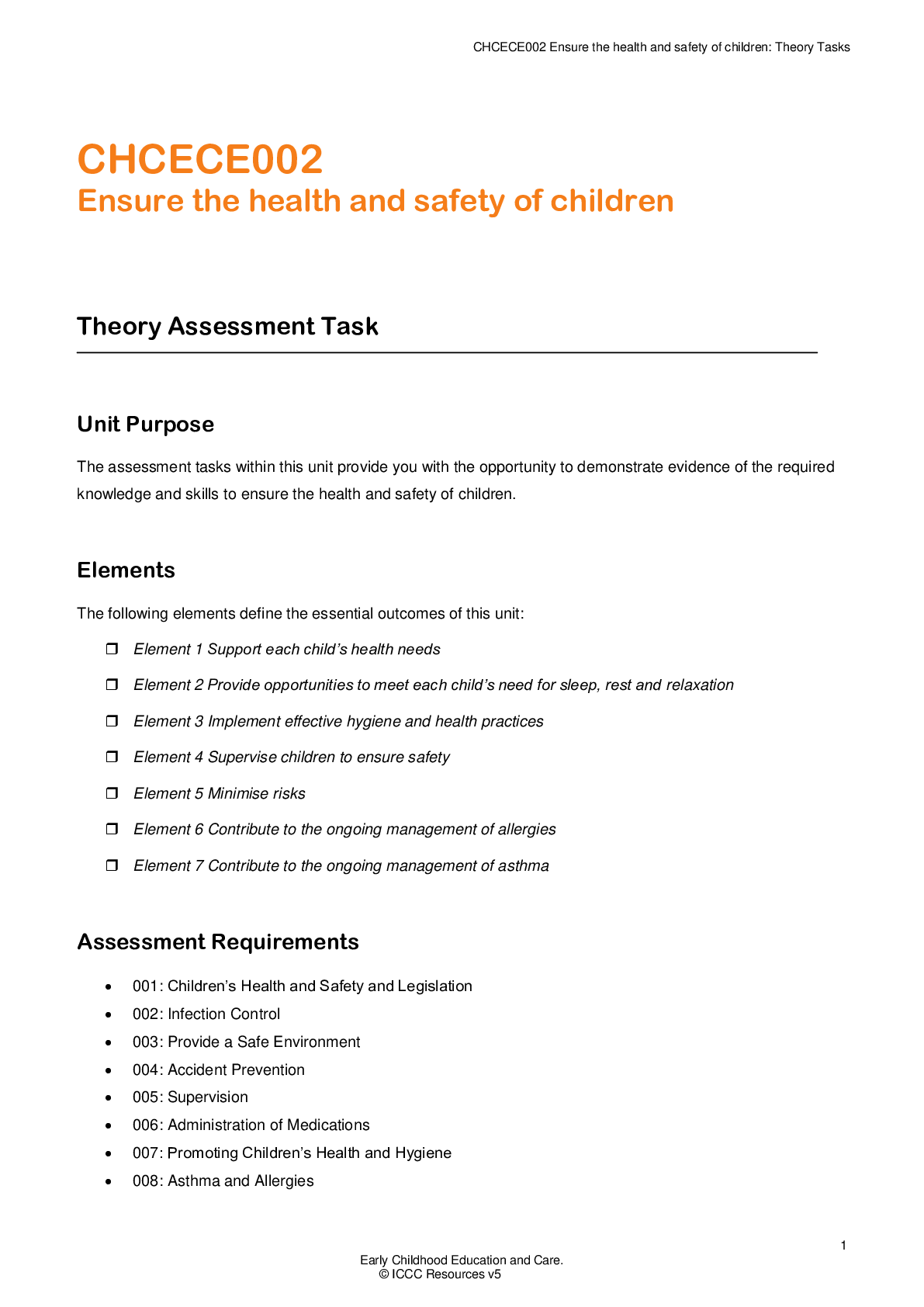
Reviews( 0 )
Recommended For You
Psychology> QUESTIONS & ANSWERS > CHCECE001 Develop cultural competence CHCDIV002 Promote Aboriginal and/or Torres Strait Islander cultural safety Theory Assessment Task (All)
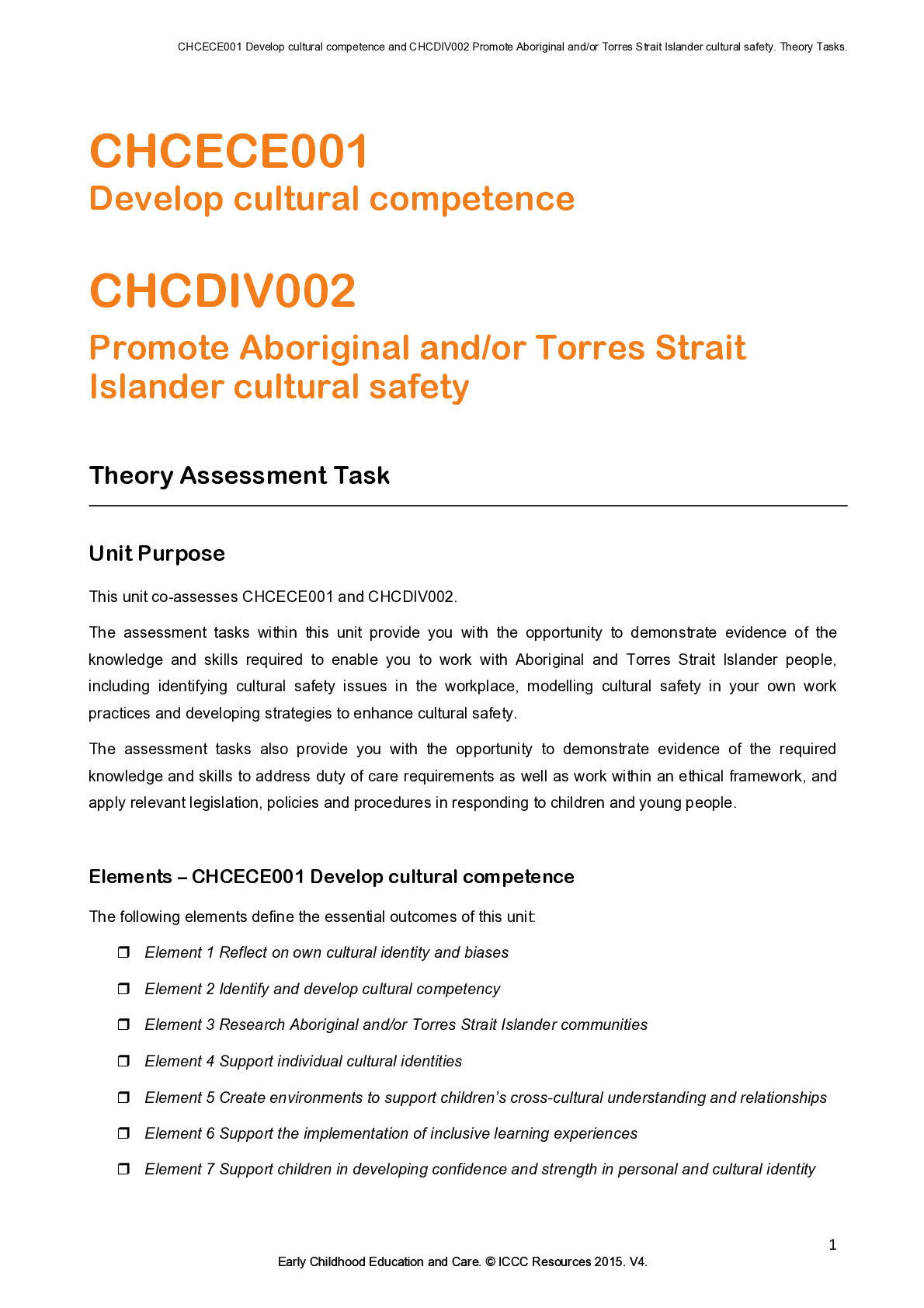
CHCECE001 Develop cultural competence CHCDIV002 Promote Aboriginal and/or Torres Strait Islander cultural safety Theory Assessment Task
CHCECE001 Develop cultural competence CHCDIV002 Promote Aboriginal and/or Torres Strait Islander cultural safety Theory Assessment Task CHCECE001 Develop cultural competence CHCDIV002 Pro...
By Kirsch , Uploaded: Jan 10, 2021
$9.5
Sociology> QUESTIONS & ANSWERS > NATIONAL INSTITUTE OF EDUCTION AND TECHNOLOGY: Training Division CHCECE002 ENSURE THE HEALTH AND SAFETY OF CHILDREN: Student Declaration and Cover Sheet. ALL ANSWERS PROVIDED (All)
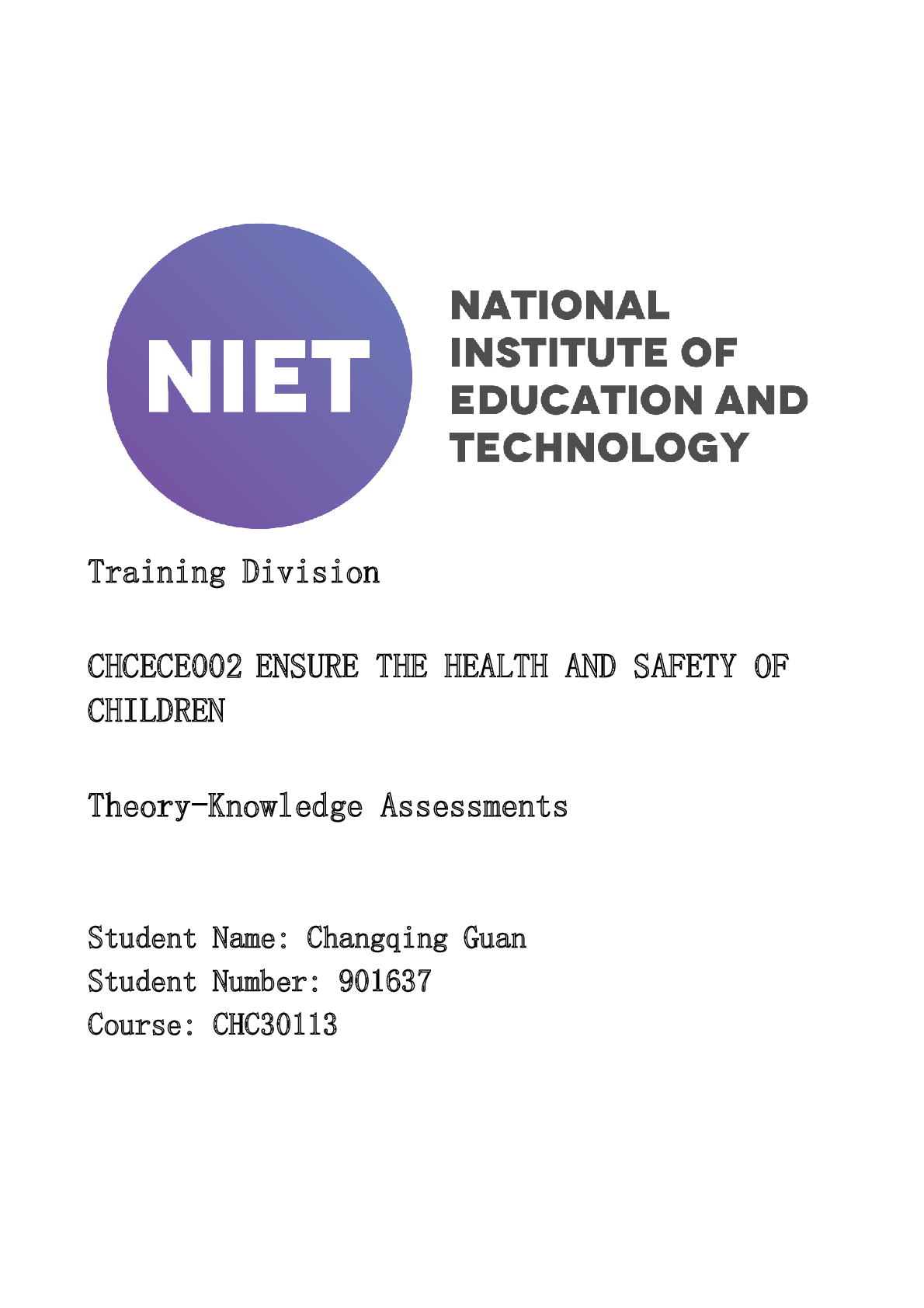
NATIONAL INSTITUTE OF EDUCTION AND TECHNOLOGY: Training Division CHCECE002 ENSURE THE HEALTH AND SAFETY OF CHILDREN: Student Declaration and Cover Sheet. ALL ANSWERS PROVIDED
Training Division CHCECE002 ENSURE THE HEALTH AND SAFETY OF CHILDREN Theory-Knowledge Assessments Student Name: Changqing Guan Student Number: 901637 Course: CHC30113 Student Declar...
By Kirsch , Uploaded: Jan 10, 2021
$12
Sociology> QUESTIONS & ANSWERS > CHCECE001 Develop cultural competence CHCDIV002 Promote Aboriginal and/or Torres Strait Islander cultural safety Theory Assessment Task (All)
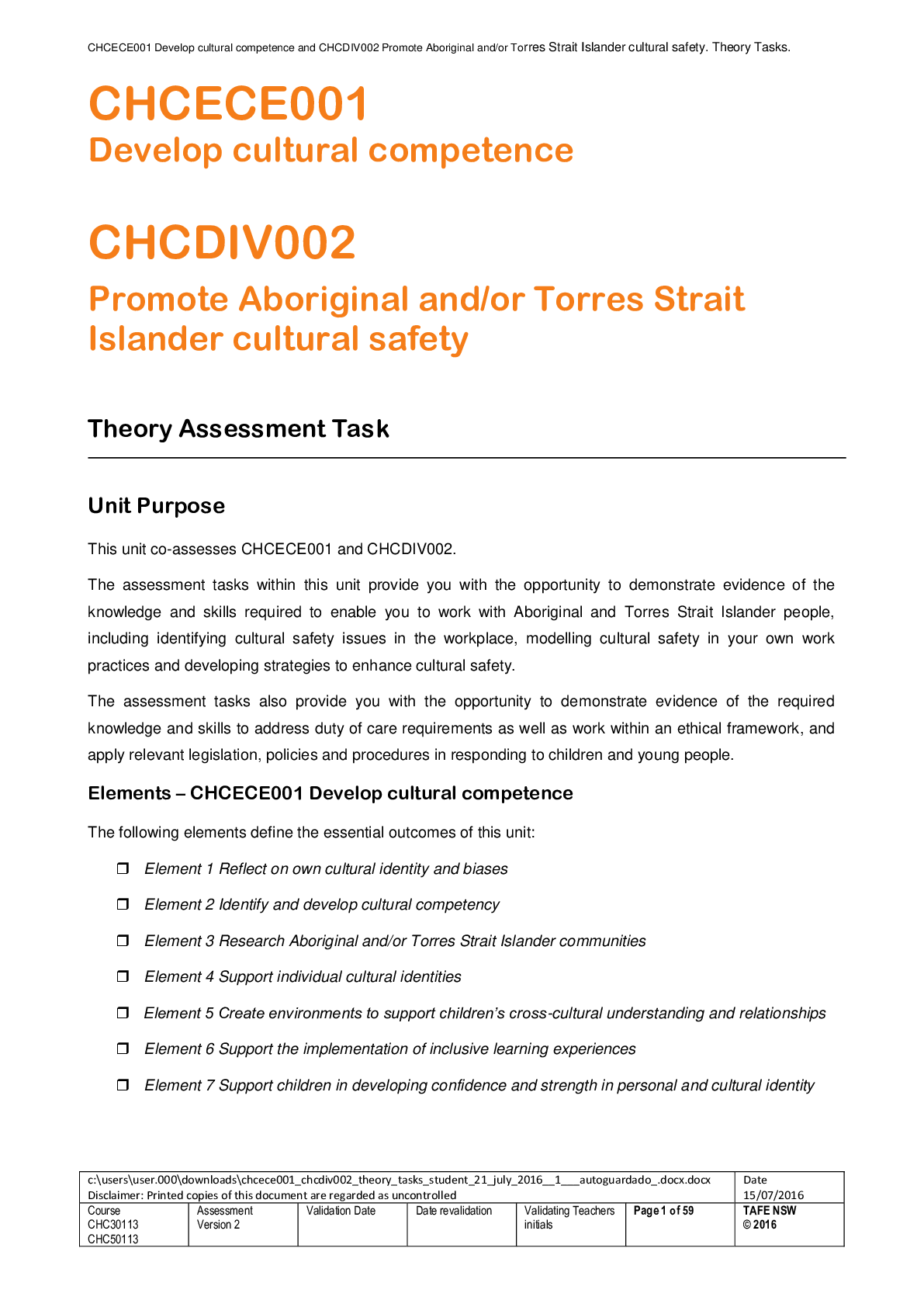
CHCECE001 Develop cultural competence CHCDIV002 Promote Aboriginal and/or Torres Strait Islander cultural safety Theory Assessment Task
CHCECE001 Develop cultural competence CHCDIV002 Promote Aboriginal and/or Torres Strait Islander cultural safety Theory Assessment Task CHCECE001 Develop cultural competence CHCDIV002 P...
By Kirsch , Uploaded: Jan 10, 2021
$11
*NURSING> QUESTIONS & ANSWERS > NCSBN TEST BANK for the NCLEX-RN & NCLEX-PN. Contains More than 2000 Q&A Plus Review and Rationale in 517 PAGES. (All)
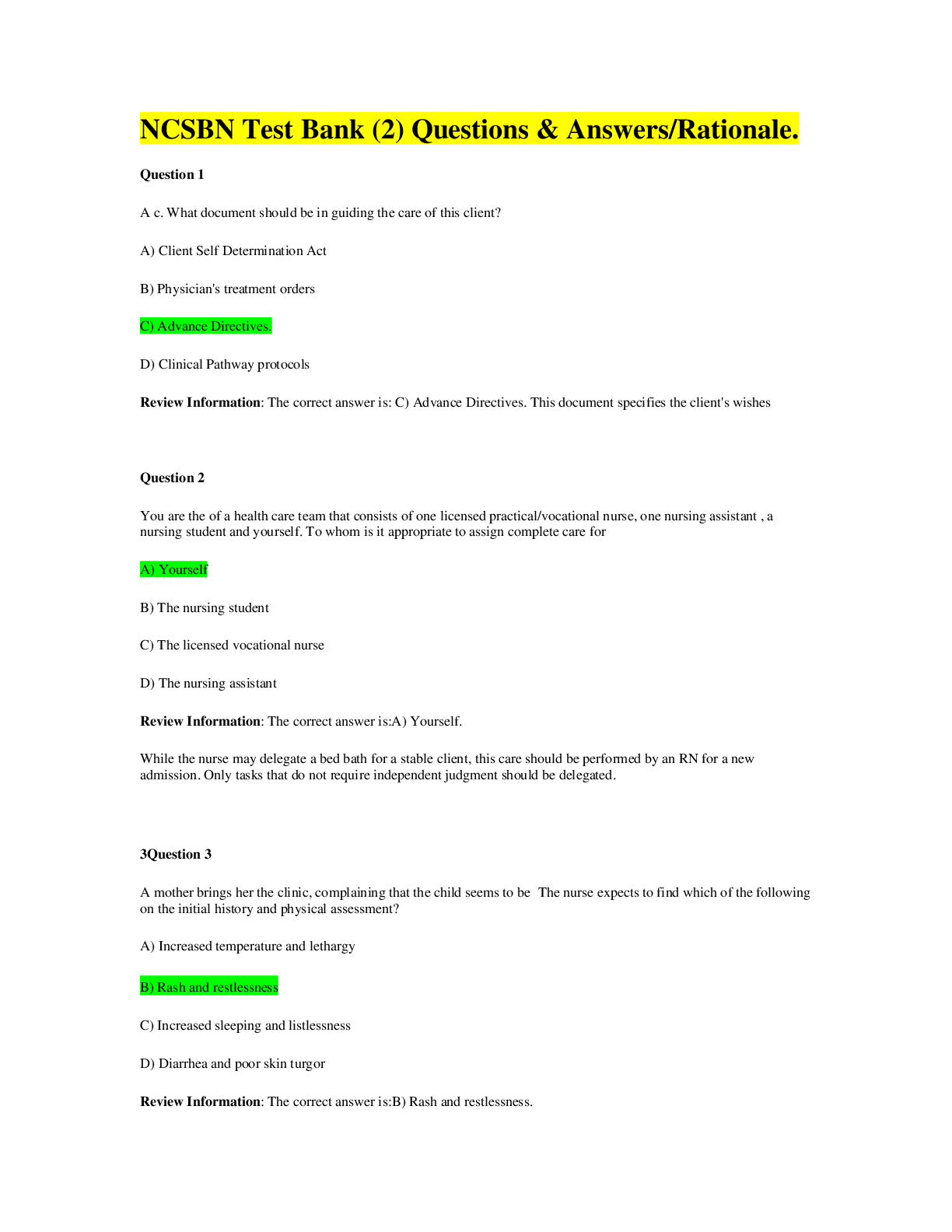
NCSBN TEST BANK for the NCLEX-RN & NCLEX-PN. Contains More than 2000 Q&A Plus Review and Rationale in 517 PAGES.
NCSBN TEST BANK -for the NCLEX-RN & NCLEX-PN. Updated 2022/2023. Contains More than 2000 Q&A Plus Review and Rationale in 517 PAGES. (All Testable Questions for NCLEX-RN & NCLEX-PN)
By Expert1 , Uploaded: Jul 28, 2020
$20
Business> QUESTIONS & ANSWERS > CLM 031 EXAM (All)
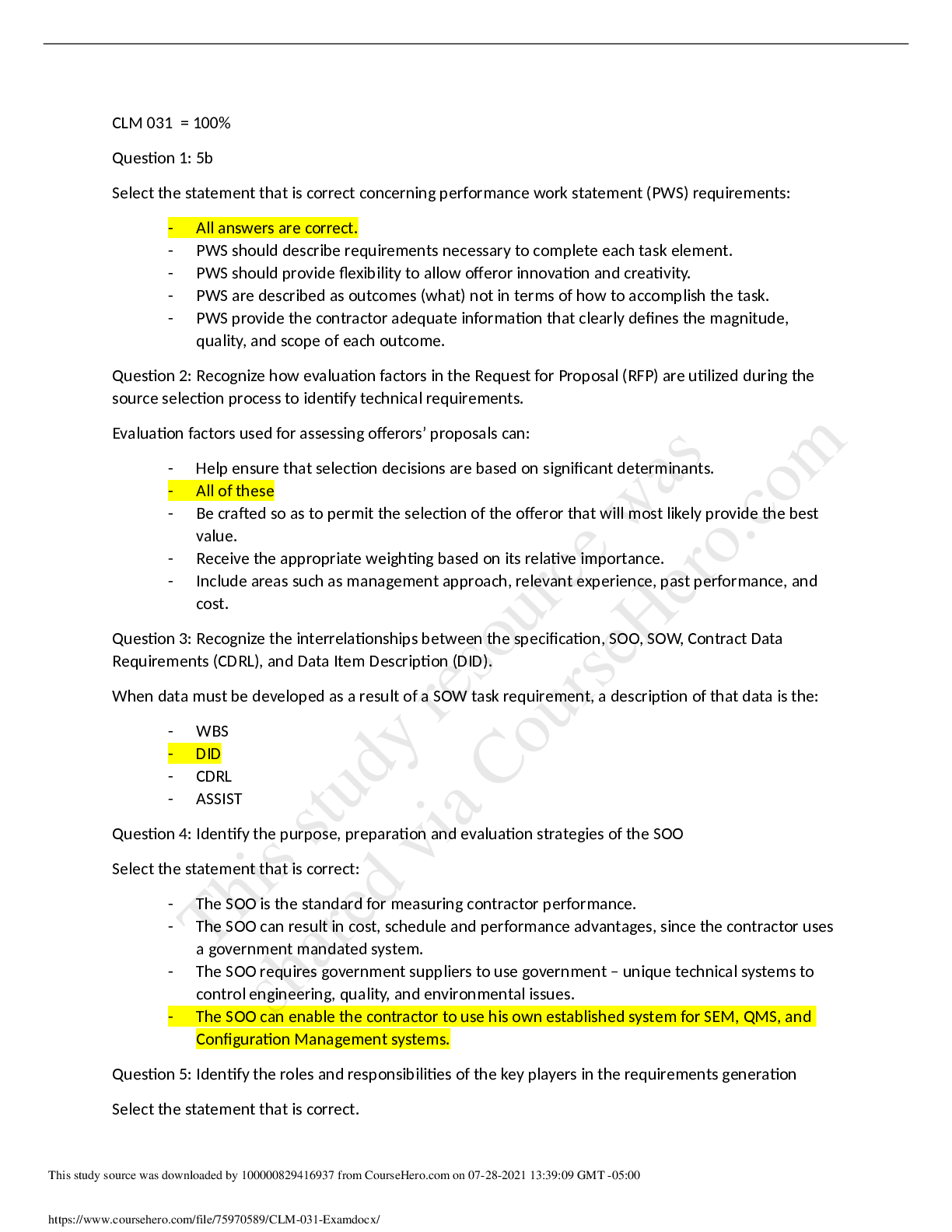
CLM 031 EXAM
CLM 031 = 100% Question 1: 5b Select the statement that is correct concerning performance work statement (PWS) requirements: - All answers are correct. - PWS should describe requirements necessary...
By Book Worm, Certified , Uploaded: Nov 03, 2022
$5
*NURSING> QUESTIONS & ANSWERS > PHIL 347 Week 6 Checkpoint Quiz. Score 100/100 (All)
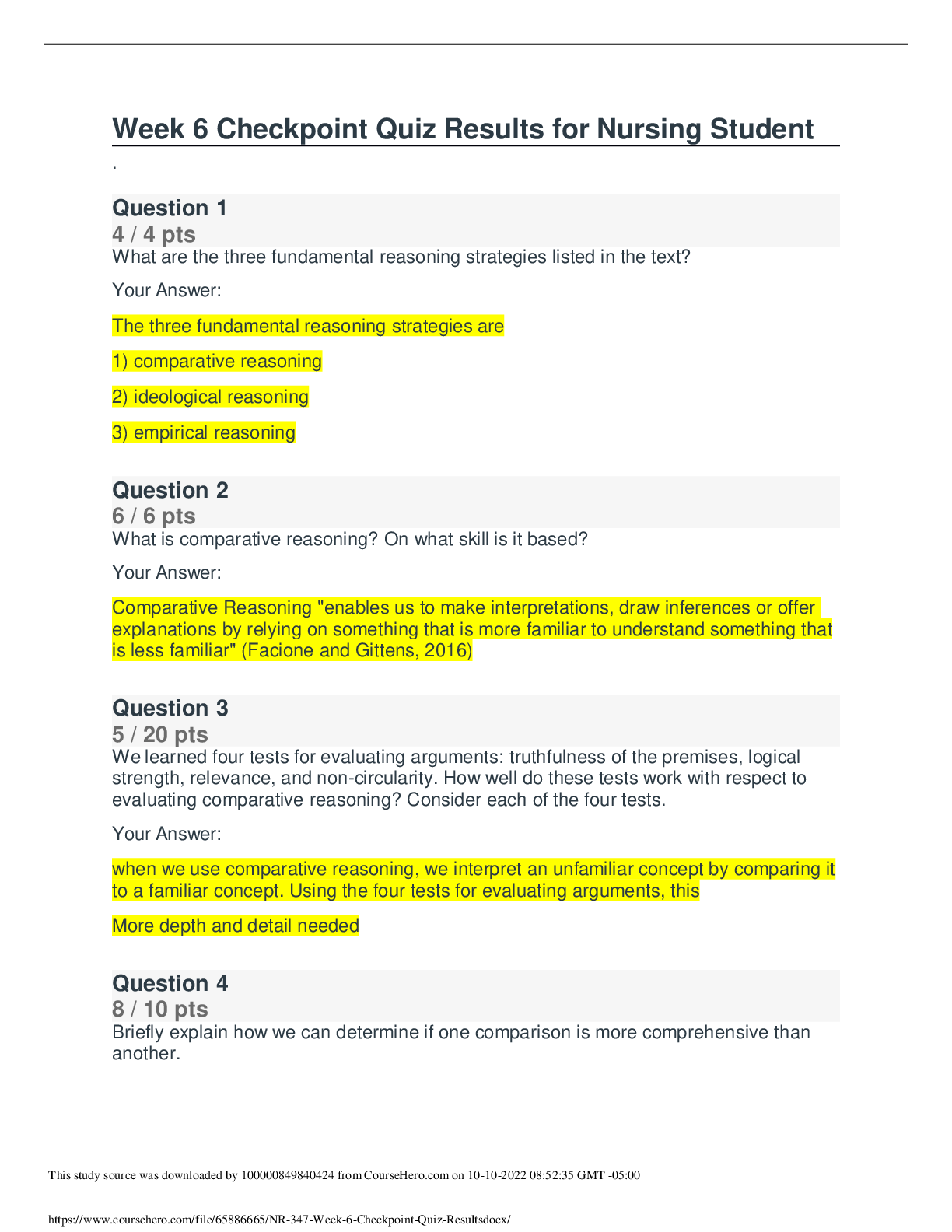
PHIL 347 Week 6 Checkpoint Quiz. Score 100/100
Question: What are the three fundamental reasoning strategies listed in the text? Question: What is comparative reasoning? On what skill is it based? Question: We learned four tests for evaluating...
By Amanda Rosales , Uploaded: Mar 24, 2021
$7
Business> QUESTIONS & ANSWERS > BUSINESS 1007 (All)

BUSINESS 1007
BUSINESS 1007 07 Key 1. (p. 178) Managers utilize organizational resources such as employees, information, and equipment to accomplish goals. 2. (p. 178) The main job of managers today is to w...
By Kirsch , Uploaded: Oct 19, 2019
$6
Anthropology> QUESTIONS & ANSWERS > KOR 352 FA19 101 week 8 Quiz. Already Graded A (All)

KOR 352 FA19 101 week 8 Quiz. Already Graded A
KOR 352 FA19 101: Week 8 Quiz Question 1 (0.25 points) Which of the following is not true of Kim and Finch’s observations during their field research in South Korea from 1997 to 2000? Question 1 o...
By Kirsch , Uploaded: Oct 17, 2019
$9
E-Commerce> QUESTIONS & ANSWERS > ESOC 316 Digital Commerce - University Of Arizona. Midterm Quiz. 20 Q&A. 100% Score (All)

ESOC 316 Digital Commerce - University Of Arizona. Midterm Quiz. 20 Q&A. 100% Score
ESOC 316 Digital Commerce - University Of Arizona. Midterm Quiz. 20 Q&A. 100% Score ESOC316 MIDTERM QUIZQuestion 6 (1 point) Saved Information has several properties that make information goods...
By Kirsch , Uploaded: Oct 15, 2019
$9.5
Marketing> QUESTIONS & ANSWERS > Marketing Management Chapter 2 to Chapter 10 Q&A (All)

Marketing Management Chapter 2 to Chapter 10 Q&A
Chapter 2 to Chapter 10 Chapter 2: Developing Marketing Strategies and Plans GENERAL CONCEPT QUESTIONS Multiple Choice 66 Chapter 1: Marketing: Managing Profitable Customer Relationships...
By Kirsch , Uploaded: Oct 14, 2019
$10
Document information
Connected school, study & course
About the document
Uploaded On
Jan 10, 2021
Number of pages
37
Written in
Additional information
This document has been written for:
Uploaded
Jan 10, 2021
Downloads
0
Views
247






